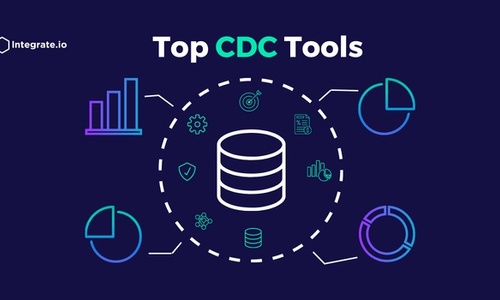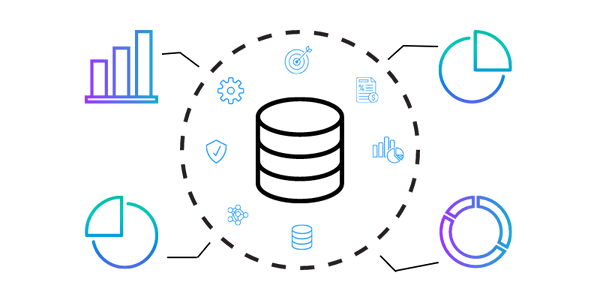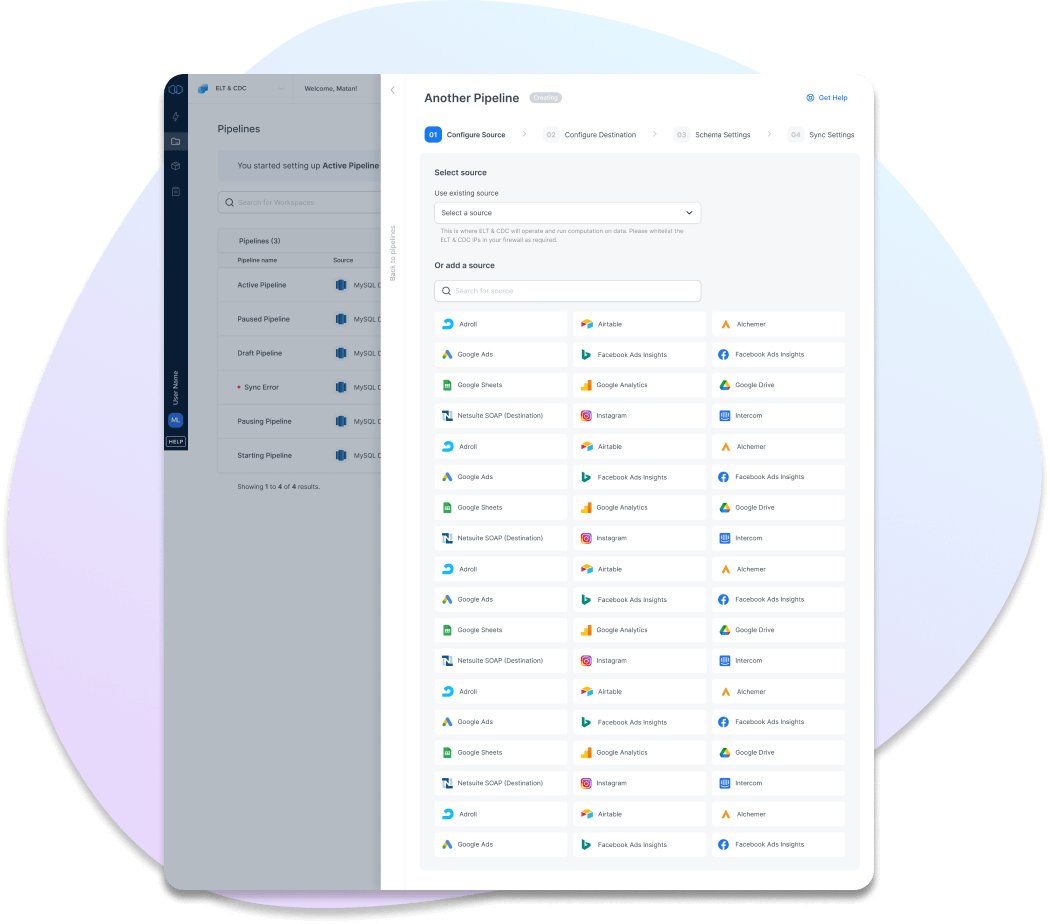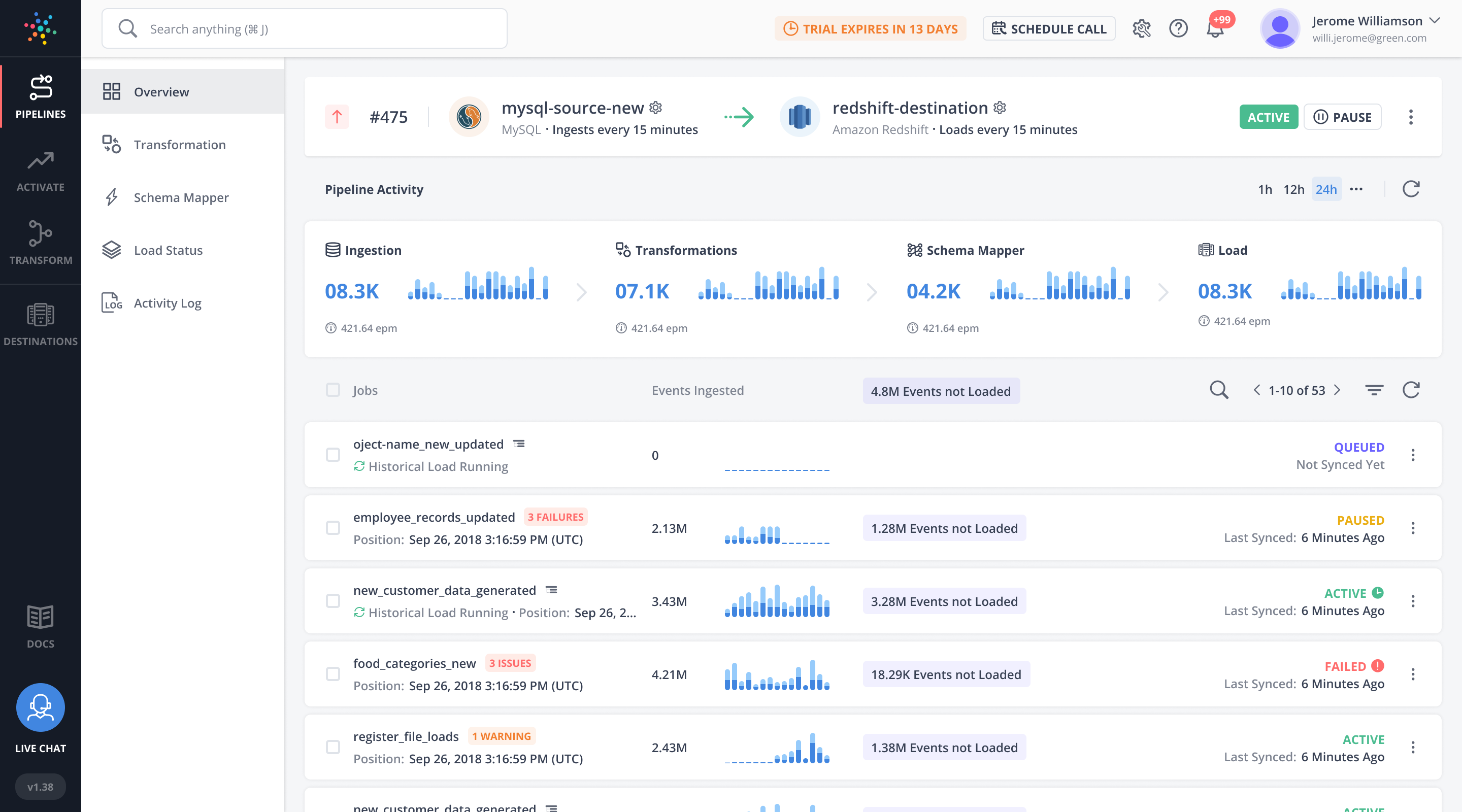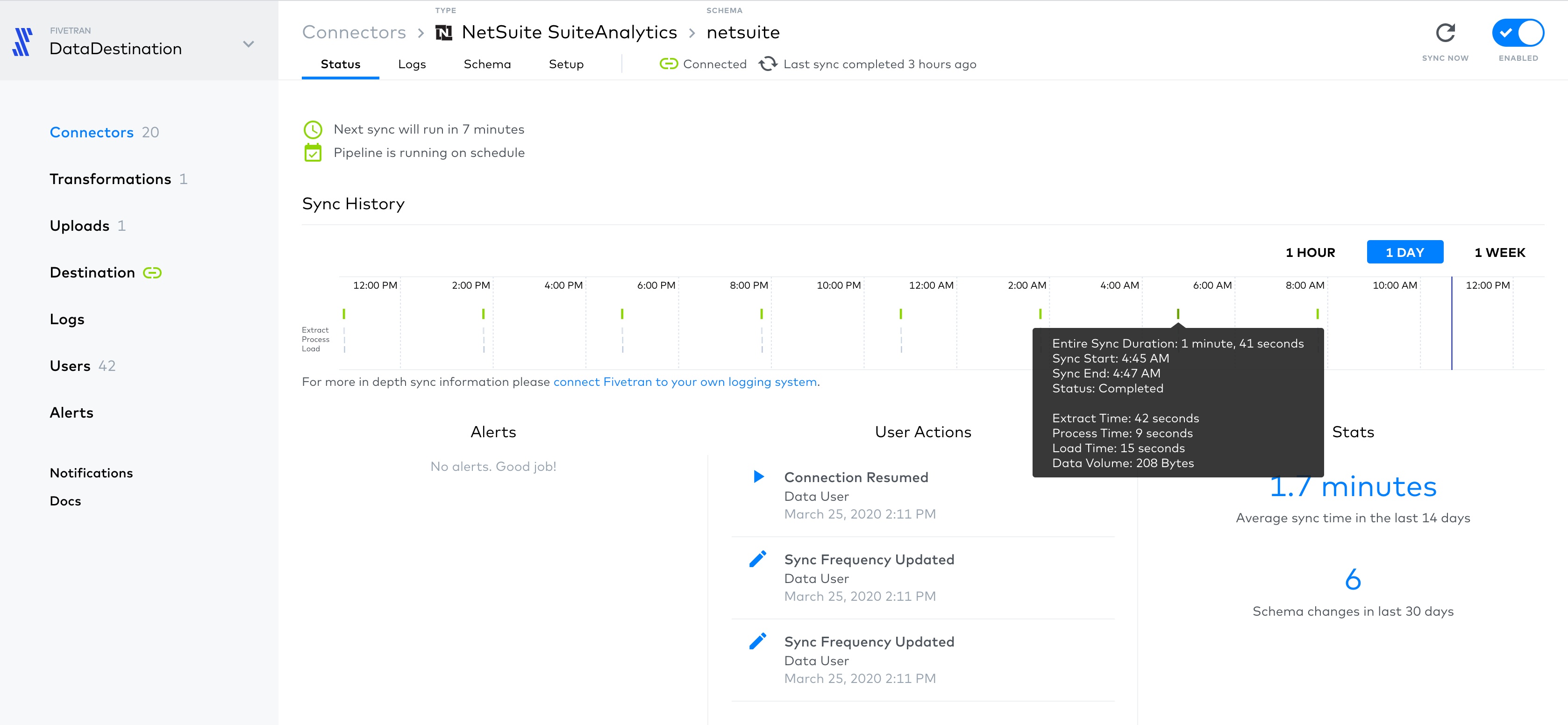Data integration is essential for any competitive business. The ability to sync all your data from disparate sources powers better insights, analysis, and ultimately faster business decision-making. Change data capture (CDC) is one element of data integration that focuses on keeping data accurate with near real-time updates as soon as data within a data source changes.
Our 5 key takeaways about the best change data capture tools:
- Change data capture (CDC) is a data integration method that involves data streaming in increments to your data warehouse or lake to ensure accurate data collation, data replication, or even entire database replication.
- Data transfer is fast because, in the CDC process, data replication occurs at the destination.
- The best change data capture tools offer automation, monitoring, and other additional features.
- Effective CDC creates complete business data that’s ready for analysis by tools such as BigQuery.
- Data managers need to consider price, capability, features, and benefits before choosing a CDC tool.
We look at the best CDC tools available, their features, pros, cons, and more.
What Are Change Data Capture Tools?
Data integration tools find ways to connect to the business apps, SaaS, and databases that are vital for your day-to-day operations and longer-term analysis. One method for this is ETL (extract, transform, load) which involves connecting to sources via data pipelines, cleansing and transforming the data in a cloud-based staging area (for cloud-based ETL providers), and loading the information into your data warehouse, such as Snowflake or Amazon Redshift.
Another method is ELT or CDC: Extract, load, transform or change data capture. This method grabs the data from your source systems fast, updating every time a data transformation event occurs at the source. CDC tools are pieces of software or aspects of a data integration platform that empowers users to create data pipelines with ease, avoiding the need for manual coding.
Why Are CDC Tools So Important?
Data integration is more essential than ever as big data continues to get, well, even bigger. The world is on track to generate 181 zettabytes by 2025, so businesses must find ways to connect to and move data for real-time analytics. ETL is fantastic for full historical data loads but doing this every time you need your data warehouse updated is resource-heavy and time-consuming. CDC brings data across in smaller increments, which is quicker and uses less network provision. This cuts costs for businesses, and ensures data is as accurate as possible, not relying on manual pulls of data or even automation—it’s the change at the data source that prompts CDC tools to connect and collect new data.
CDC is also essential for avoiding latency. Because CDC updates your target system in incremental workloads, your systems won’t suddenly start lagging while heavy load queries get processed. Streaming data in real time can help with many emerging aspects of business technology, such as machine learning models that rely on huge data stores that are constantly shifting.
How Do CDC Tools Work?
CDC tools have the ability to detect row-level changes in relational database tables, such as “delete”, “update”, or “insert” events. These changes ultimately act as notifications for the CDC software to connect and draw the adjusted data from the source to the destination, and in some cases, any other system that relies on this data.
The change data capture process works as follows:
- CDC tools extract any data that’s changed at the source.
- Tools load data directly into the data destination for data ingestion.
- The tool leverages the data destination's resources to ensure data is transformed in line with the destination format—this may involve standardizing, cleansing, sorting, and verifying different aspects of the data.
Because data only updates in the exact order it changes at the source, this avoids data duplication in your data lake or warehouse, maximizing the effectiveness of your available resources.
The 5 Best CDC Tools Available Now
What should you look for when searching for the best change data capture tools?
Top features include:
- Ease-of-setup and -use
- No-code or low-code interfaces
- Pre-built connectors or data pipelines
- Additional services, such as data analytics or multiple types of data integration solutions
- Data monitoring and anomaly detection
Take a look at the five best CDC tools on the market right now.

Integrate.io
Integrate.io provides a complete data integration platform that provides users with ETL, reverse ETL, and super-fast CDC capabilities. The no-code drag-and-drop interface eliminates the pain points involved with tedious manual coding of data pipelines. This also empowers personnel beyond data managers and engineers to get involved with data integration and analysis.
Pricing: Integrate.io pricing is tailored exactly to each client's needs and requirements with a usage-based component couple with features and functionality. Clients choose which level of platform usage they will require and then which features and functionality to create a custom plan to fit their use case.
Features: Integrate.io comes with over 100 out-of-the-box connectors to popular business SaaS, customer relationship management (CRM) tools, enterprise resource planning (ERP) solutions, and many more. The award-winning platform provides enterprise-level cybersecurity, field level encryption, and is completely scalable. G2 recently named Integrate.io as a “Momentum Leader”.
Reviews: Integrate scores highly on ease of use and setup, and really shines when it comes to support. One five-star review from an associate data analyst stated that they loved the automation tools available and the ability to connect to so many different apps and systems. Others cited ease of use, flawless data replication, and a “partner success mentality” as primary reasons they continued to rely on Integrate.io for their CDC requirements.
Pros:
- Huge volume of pre-built connectors
- Award-winning service
- Complete platform of data integration services including CDC
- Speed and ease of setting up data pipelines
Cons:
- Could be a learning curve for those with no data management experience whatsoever, however, the excellent support team is on hand to help with this
Talend Cloud Data Integration
Talend is a big name in data management and integration, and it won’t surprise many to see their iPaaS on our list. What might surprise you is to learn that their overall ratings aren’t any higher than some of their “smaller” competitors, scoring 4.3 out of 5 on G2 as of April 2023.
Pricing: Talend offers bespoke pricing options at a mid-market to enterprise range.
Features: Talend’s website promotes their “deep partnerships and integrations” with big tech names like AWS and Snowflake, which provides peace of mind to businesses that already work with these providers. Talend is also one of Gartner’s Magic Quadrant Leaders. Talend combines CDC with API management for the integration of multiple data types that are usable in a single data destination fast. Talend also promotes that their pipelines run in any environment, avoiding vendor lock-in.
Reviews: Talend scores around 8.5 out of 10 on ease of use, setup, and support. Reviews highlight that the services are scalable and that the visual interface makes it easy to connect with both on-premise and cloud-based databases. However, reviews also emphasized that Talend is expensive and has limited functionality which doesn’t always justify the high cost. One marketing media planning specialist stated the platform has “High cost and limited functions” and noted several issues including poor speed, performance, and limited algorithms.
Pros:
- Comprehensive built-in monitoring solution
- Excellent data cleansing/standardization/organization
- Related functions grouped together for ease of use
Cons:
- Low memory/resources leading to slow speed and poor performance
- Some tools are too basic for complex data tasks
- Expensive
Related reading: Talend vs. Integrate.io: Comparison and Review

Hevo Data
Hevo Data is a bi-directional data integration platform, which means it offers ETL, reverse ETL and ELT/CDC. Like others on our list, it’s a no-code solution, empowering users to create data pipelines with ease.
Pricing: Hevo Data offers a free demo, and the basic package starts at $249. Pricing scales up or down depending on user requirements.
Features: Hevo Data focuses on zero data loss, promising that when things go wrong, data will be retrievable while the platform will allow users to quickly find the root cause of an issue. Hevo promotes near real-time data analytics via accurate data movement and replication, and links to over 100 data sources.
Reviews: Hevo Data scores very highly on ease of setup, ease of use, and quality of support. Reviewers particularly noted that support was on hand during the initial set up to help iron out any wrinkles. One reviewer said, “…you might face some issues while setting up, but the support team is there to help you out, hence all in all, I think it is a good product.”
Pros:
- Large number of integrations
- Automatic data identification
- Ease-of-use
Cons:
- Existing pipelines are difficult to edit
- Deleted pipelines retain previous identifiers permanently which can cause confusion
- Error messages don’t always suggest next steps
Related reading: Hevo vs Fivetran vs Integrate.io: An ETL Tool Comparison

Fivetran
Fivetran provides a no-code, zero-configuration data integration solution. Their tagline is that it’s shaped by real-world data analyst requirements.
Pricing: Starter and standard plans are charged on a pay-as-you-use basis while enterprise plans are offered on a case-by-case basis.
Features: The enterprise plan offers advanced data governance tools as well as ETL and CDC options for data integration. Automation allows users to set data migration at 5-minute intervals or as changes occur. Fivetran offers its own REST API for additional connectivity.
Reviews: Fivetran scores highest in the ease-of-setup category, while scores drop a little when it comes to service and support. One review stated that pricing was opaque and support unhelpful. Conversely, though, another called Fivetran a “lifesaver” and highlighted how fast and reliable the service is.
Pros:
- Broad range of data connectors
- Automatic schema migrations
- Everything above the starter plan supports unlimited users
Cons:
- The pay-as-you-use model can get expensive as businesses scale their data requirements up
- Starter plans only allow limited users
Related reading: Fivetran vs Integrate.io: Overview and Comparison
Qlik Replicate
You might know Qlik Replicate as Attunity, which was its previous incarnation. Qlik supports data movement and replication across dozens of databases, big data platforms, and data warehouses, utilizing a variety of methods including CDC.
Pricing: Businesses must contact Qlik for a custom quote.
Features: Qlik’s real-time data replication tool includes data governance tools and monitoring solutions. It’s another tool that’s recognized by Gartner on the Magic Quadrant thanks to high scalability and automation options.
Reviews: Unlike all the other tools on our list, Qlik scores much lower in the “ease-of-setup” category. This could be because there’s less support available, or the system assumes a certain level of tech-savviness that not all users may possess. Positive reviews praise the fact that there’s an on-premise version as well as the cloud-based solution.
Pros:
- Streamlines data ingestion and replication
- Large volume of sources and destinations
Cons:
- Reliability issues including freezing or having to implement a full reload of data if syncing fails
- Lack of product support
- Poor error message clarity
Which Change Data Capture Tool Is the Best?
Choosing the right CDC tool will, of course, depend on your use case scenario and the experience of your DataOps teams. Of our five top CDC tools, each one has features that impress some users, while other aspects may not suit every business:
- Talend offers a variety of features but is often too expensive for smaller businesses.
- Hevo Data is popular thanks to its wide variety of connectors to source databases and destinations yet lacks the in-depth monitoring capabilities of more expensive platforms.
- Fivetran also supports multiple connectors and is praised for its ease of use, but some users complain that support is lacking, and the pricing is unclear or escalates quickly.
- Qlik Replicate provides monitoring and data governance tools including a detailed transaction log, but the level of complexity is beyond some entry-level users and reliability can be an issue.
If you want an iPaaS that utilizes CDC alongside other data integration methods, that's easy to use and offers excellent user support every step of the way, reviews show that Integrate.io is the best, award-winning CDC solution available right now.
Common CDC Use Cases
You know that CDC tools grab data from a variety of sources and upload it into your data warehouse. But why do you need this? The answer is: for any number of reasons.
Change data capture (CDC) is a process used to track changes in a database and capture them in real-time, enabling other systems to consume this data as it is updated. A common use case for CDC is in data warehousing or data integration scenarios, where real-time updates are necessary to keep a data warehouse or other downstream systems up to date with changes in the source database.
For example, let's say that a company has a transactional database that is constantly being updated with new orders, customer information, and inventory changes. This database feeds into a data warehouse that is used for reporting and analytics. Without CDC, the data warehouse would have to periodically refresh its data from the transactional database, which could result in delays and outdated information.
By using CDC, changes to the transactional database are captured and sent to the data warehouse in real-time, ensuring that the data in the warehouse is always up-to-date. This allows analysts and other users to access the latest information without having to wait for a batch process to run, and it ensures that reports and dashboards are always accurate and reflect the latest information.
CDC Tools: How Integrate.io Can Help
If you're looking for the best CDC tools, we’re confident that Integrate.io has the features you need to manage your data better for more actionable data warehouse insights.
Integrate.io's powerful change data capture (CDC) technology ensures that your data warehouse is always in sync with your source database, allowing you to make faster, data-driven decisions. Try Integrate.io out today with a 14-day free trial and see the difference CDC can make for your business.
